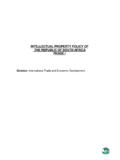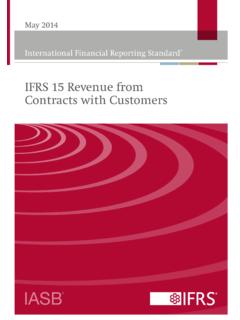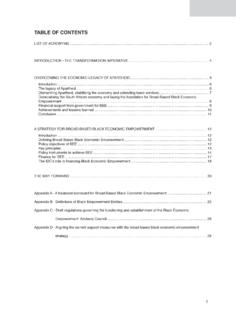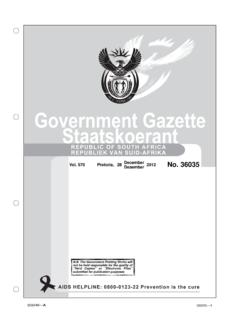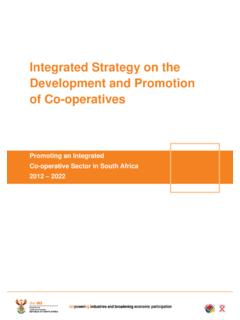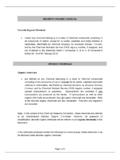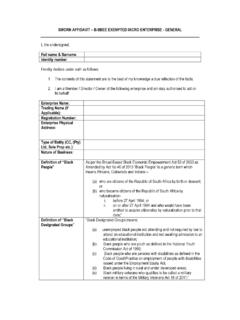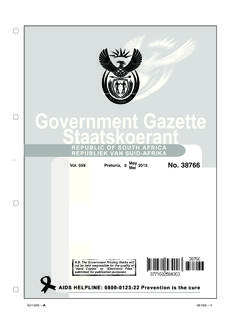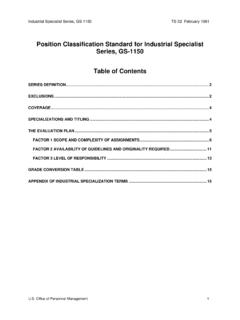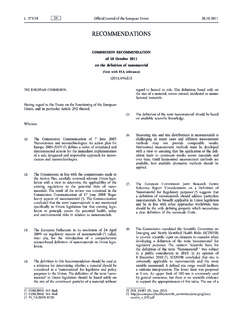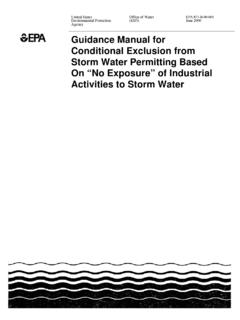Transcription of Industrial Policy Action Plan 2017/18 - 2019/20
1 Industrial Policy Action plan 2017 /18 - 2019/20 Economic sectors, infrastructure and employment cluster 1 Presentation to the Portfolio Committee on Trade and Industry 13 June 2017 Contents Policy context Core objectives Transversal and sectoral focus areas 2017 /18 Selected transversal highlights 2016/17 Selected sectoral highlights 2016/17 Themes for 2017 /18 Overcoming challenges Global context with supporting data Domestic context with supporting data 2 3 Policy Context 1: Situating IPAP Aligned to both the Medium Term Expenditure Framework (MTEF) and the Medium Term Strategic Framework (MTSF) Special focus on minerals and beneficiation, agriculture and agro-processing, energy, attracting investments and growing the oceans economy A key component of the President s Nine-Point plan Informed by the vision set out for South Africa s development provided by the National Development plan (NDP) Located within and provides one of the key programmes of the New Growth Path (NGP) Policy Context 2.
2 Embedding IPAP 4 Economic restructuring IPAP supports radical economic transformation by an on-going effort to fundamentally change the structure of the economy The focus is on patterns of ownership, management and control, with a central emphasis on the manufacturing sector Employment & integration Sustainable job creation is a key priority. Hence: an ever-stronger focus on labour-intensity in key sectors of the productive economy and the integration of primary, manufacturing and service value chains across sectors Policy Context 2: The importance of manufacturing 5 There are very few if any cases, at any time in economic history, where a country has achieved sustained and sustainable economic development, that have not been led by manufacturing The manufacturing sector has high economic multipliers because of its value-addition, linkages to the upstream production sectors of the economy (mining and agriculture) and the downstream sectors, including services.
3 And because of its all-round contribution to strengthening integrated value chains The growth of the manufacturing sector has multiple macro-benefits: Value-added exports break dependency on resource exports Reduced vulnerability of the current account to commodity cycles Limits currency volatility SA has amongst the world s highest reserves of minerals, which must be used to build competitive capabilities and advantages Certain manufacturing sectors have high employment multipliers across the value chains Manufacturing drives technology and innovation through technology absorption and diffusion and research and development Manufacturing supports and enables the growth of national skills capacity and capabilities and the movement towards a knowledge economy IPAP core objectives 6 3 Building regional investment, trade and Industrial development integration 5 1 Diversifying the economy and providing strong support for value-added manufacturing 2 Developmental model focused on radical economic transformation and social inclusion 4 Emphasis on R&D and movement towards a knowledge economy Working with the private sector to prepare for and adapt to the challenges in digitised production and logistics associated with the 4th Industrial Revolution IPAP transversal focus areas 2017 7 IPAP sectoral focus areas 1 8 IPAP sectoral focus areas 2 9 Achievement highlights 2016/17 10 Securing SA s primary steel production capability and supporting the downstream steel sector Agreement with the primary steel producer on a set of principles for flat steel pricing in SA that is priced appropriately to ensure competitiveness of
4 Steel-dependent industries and sustainability of upstream steel mills Tariff increases for a range of steel products to protect industry from dumping ; tariff review on a range of downstream products and the deployment of rebates Local procurement by government through the designation of steel and steel products Settlement of the Competition Commission issues with AMSA Investment support through the dti 12i tax allowance programme for plant, equipment and building upgrades as well as training support Establishment of a Steel Development Fund to support key downstream steel sectors/sub sectors Achievement highlights 2016/17 11 Industrial Financing & Incentive Support: supporting private sector investment and black economic empowerment in critical Industrial sectors Automotive Investment Scheme: on investment leveraged through 2 new projects with an estimated investment value of , projected to create 1 140 jobs Manufacturing Competitiveness Enhancement Programme (MCEP): R1bn loan component reopened; 270 projects supported; disbursed, supporting bn of investments & 62 2353 jobs 12i Tax Allowance Incentive Scheme: April 2015 September 2016, 49 projects approved with an investment value of Aquaculture Development and Enhancement Programme (ADEP): approved for 17 projects, with a projected investment value of.
5 474 jobs created Achievement highlights 2016/17 12 Black Industrialists Development Programme: 27 approved projects to the value of R577m, with a projected investment of bn and a projected 5, 235 direct and 1,228 indirect jobs to be created R&D tax incentive supported bn in R&D expenditure Export Marketing and Investment Assistance Scheme (EMIA): support package of R90m and export sales of bn Industrial Development Corporation (IDC): disbursed R8bn, created and saved 14,636 jobs Export Credit Insurance Corporation (ECIC): approved m for 3 major export-related projects with a local content value of bn achieved Achievement highlights 2016/17 13 Technology and Innovation Agency (TIA): since 2013, disbursed in excess of R1bn; approximately 70 of the technologies funded reached demonstration stage; 23 technologies successfully commercialised Industrial Park Revitalisation Programme (IPRP): R180m spent on upgrading 6 Industrial parks in 2016 (R216m set aside for 5 additional Industrial parks) Cluster Development Programme: 6 cluster initiatives totalling approved, in the medical device, composites, non automotive, advance manufacturing, pharmaceuticals and creative industries Achievement highlights 2016/17 14 Technology Localisation Programme (TLP) DST provided funding of R9m for the Bombardier locomotive building project; total revenue to be generated is R350m, with a full local content value of R350m (100%) TLP outputs and impacts 2012-Aug 2016: No.
6 Of companies supported towards the development of new products 16 Total direct jobs created due to the implementation of FTAPs 650 No. of companies where export capability was developed 22 No. of companies supported where import substitution was achieved 20 No. of companies that have gained work with SOCs 57 No. of companies supported where SOC/OEM work has been retained 65 Jobs retained at companies supported 6,500 Percentage of companies supported that are black women-owned 40% Achievement highlights 2016/17 15 InvestSA: securing foreign direct investment in a difficult economic climate: Government has established a national investment One Stop Shop and will open provincial centres in KZN, GP and WC; thus securing a streamlined, inter-departmental clearing house system InvestSA was awarded the Global Investment Promotion Agency (IPA) Award for excellence In 2016, South Africa FDI inflows increased at 38% year-on-year Investments by Nestle, Beijing Automotive International Corporation, ACWA Power, Ford, Toyota, Sumitomo Rubber, Cipla, Johnson & Johnson, 3M, amongst others, have reaffirmed South Africa as a regional manufacturing hub Public Investment (PI) PI increased by R14 bn to R272 bn in 2015; R36 bn in power generation projects and R35 bn in railway equipment Achievement highlights 2016/17 16 Clothing, Textiles, Leather and Footwear (CTLF): supporting and growing a key labour-intensive sector dti support amounts to billion since inception.
7 70,000 jobs saved and estimated 9,550 jobs created 28 new companies established; creation of 2 200 jobs; growth in exports Production of footwear grew by over 2 million pairs in 2016 Agro-processing: securing investment and provision of economic infrastructure in another critical labour-intensive sector: Close to R15 billion private sector investment leveraged through projects by Nestle, AB Inbev, GWK Farm Foods and Citrus and Deciduous Fruit industries R100 million tomato processing Dursots-All Joy plant launched in Tzaneen, to employ 300 people Two Agri-parks are operating while 6 are under construction; Clover, Tiger Brands, McCain and Distell have initiatives to improve market access for small farmers 17 Business Process Services: ongoing effort to build this globally competitive and labour-intensive sector 6 new projects approved, 5-year projected export revenue billion.
8 Million disbursed, 10,466 jobs sustained Call Centres - EXL call centre in Cape Town plans to create 6,000 jobs SA secured 2 projects to provide tutor services to learners in Asia via online platform, 688 jobs created Since inception of the Monyetla Work Readiness Programme, has seen provision of training opportunities to over 16,000 unemployed youth, with the placement rate well over 70% Achievement highlights 2016/17 18 Metal Fabrication, Capital And Rail Transport Equipment: rebuilding and supporting a key Industrial sector SA s efforts to up-scale our Industrial capacities and capabilities in the manufacture of rail transport and components were boosted by the launch of several new facilities: Bombardier Transportation Propulsion and Control facility launched in Elandsfontein with 100 people employed AVK Valves, in partnership with Premier Valves, launched a R200m new plant in Benoni MTU South Africa unveiled its newly-upgraded workshop facility to assemble the diesel engines for the 232 diesel locomotives for China North Rail Rail localisation Gibela secured 32 local suppliers for the R51bn Passenger Rail Agency of South Africa (PRASA) contract; 580 trains to be built in SA Rail signalling components designated for local procurement Achievement highlights 2016/17 19 Automotives: supporting and strengthening SA s globally competitive sector Through the APDP incentive, billion has been disbursed which unlocked billion in private investments.
9 For example: Beijing Automobile International Corporation (R11 billion) Toyota SA ( billion) Ford SA ( million) Volkswagen SA (R120 million) Mercedes-Benz and Government (R130 million) These investments are expected to create approximately 4,720 direct jobs Work is well advanced on an Automotive Masterplan (post-2020) to secure higher economic impacts Achievement highlights 2016/17 20 Green Industries: supporting the development of new Industrial capabilities Renewable Energy Independent Power Producer Procurement Programme (REIPPPP): 6 rounds of bids attracted investment of R billion, including R 53 billion (27%) from foreign sources. 28,484 job created IDC signed agreement with the French Development Agency (Agence Fran aise de D veloppement - AFD), for a EUR 60-million credit line for a local small-scale green project Supply side measures include: The National Cleaner Production Centre (NCPC) working with Unido - assisted 160 companies billion saved in energy costs, 1,744 jobs created/preserved Achievement highlights 2016/17 21 Beneficiation Fuel Cells: a key platform for technology-intensive investment and for building globally competitive domestic capability Fuel Cells are a key area for collaboration between the mining industry, manufacturing and government Key projects.
10 CSIR/Busmark (local OEM)/HySA for a bus prototype Anglo Platinum collaborating with HySA Infrastructure on developing fuel cell powered mining equipment Implats and its partners deployed a fuelling station using the locally developed system - metal hydride compressor Impala/Doosan project - Feasibility studies for potential deployment of 85MW Doosan systems under way; to be serviced by proposed SA manufacturing facility Isondo Fuel Cell plant launched in Cape Town Achievement highlights 2016/17 22 Beneficiation - Metals and Minerals: building competitive capabilities from SA s resource endowment: The Chamber of Mines Research Organisation (COMRO) has re-opened with funding from the DST to secure upstream mining localisation and downstream beneficiation. Tronox o
